I have long been fascinated by the influence of World War II on British thriller writers, but have finally abandoned my campaign to influence commissioning editors in the subject. I will instead share a few of my early thoughts through this occasional column and highlight novels written before, during and after the war.
I will concentrate mainly on British thrillers because that is what I was brought up reading (with some notable exceptions) and thrillers rather than straightforward war stories, however thrilling they may be. To give an example, I would class Alistair MacLean’s HMS Ulysses as a superb war story, whereas his South By Java Head is a thriller. Several will be better known as crime or detective fiction, but as author Graham Hurley (whose work will get very honourable mention in a future column) has said: WWII was the biggest crime scene in history.
Herewith more novels featuring spies, crooks, amateur detectives, policemen and lots of nasty Nazis, which were written and published during the war.
LESLIE CHARTERIS – The Saint at war
Simon Templar, alias The Saint, as created by Leslie Charteris (1907-1993) was the thriller fiction bridge between Buchan and Bond. A mixture of knight errant, thief, spy, modern-day Robin Hood, confidence trickster and all-round rogue not afraid of the rough stuff who always ended up on the side of the angels, The Saint seemed to have a relatively quiet war. Although British, he remained mostly in America, often acting as a willing agent for the FBI in their fight against spies and saboteurs, his adventures chronicled in several novellas and two novels. In The Saint Steps In (1944) a woman asks Templar why he was not in uniform, to which he swiftly replies “I got fired and my uniform happened to fit the new doorman” but even out of uniform, he is quickly involved in the hunt for a missing scientist and his valuable formula for the production of synthetic rubber, keeping both out of the hands of Nazi agents.
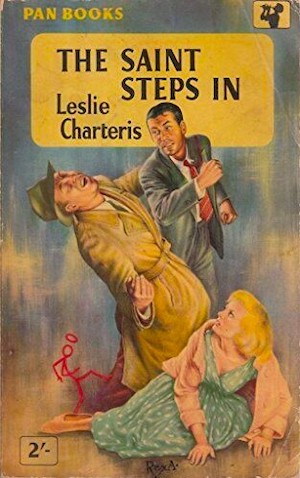
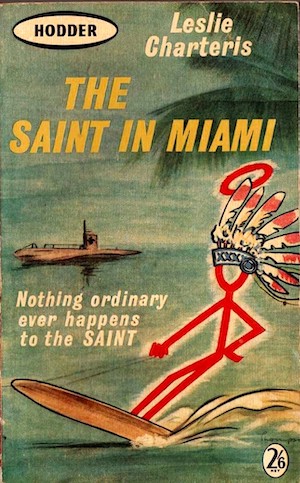
Before America’s official entry into the war The Saint In Miami (1940) had our saintly hero tangling with Nazi Fifth Columnists and U-boats on the coast and in the Everglade swamps of Florida. Charteris is reported as having said that to be credible, The Saint’s contribution to the war effort had to be minimal in that he did not want Simon Templar doing anything more heroic than ordinary people were doing every day. In The Saint On Guard novellas (1944) he did however find time to thwart the hijacking of a shipment of iridium and prevent sabotage in a weapons factory.
A.G. MACDONELL – The Crew of the Anaconda (1940)
Archibald ‘Archie’ Gordon Macdonell (1895-1941) was a Scottish journalist who made his name with the satirical?England, Their England?in 1933, but also wrote plays, detective stories (as Neil Gordon and John Cameron) and broadcast for the Empire Service of the BBC. He was also the driving force behind the formation of the Sherlock Holmes Society in 1934. As far as I can tell, The Crew of the Anaconda was his only full-blown thriller and I get the impression he had a lot of fun writing it despite the onset of the second world war, especially as he had been invalided out of the army with shell shock in the first one.
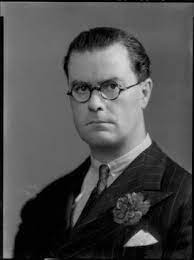

Billed as ‘a secret service thriller’ The Crew of the Anaconda features an Irish hero, the captain of the titular high speed motorboat, and, unsurprisingly, his crew of three. All of them have rather shady pasts, mostly acquired during Prohibition in America or with various South American gangsters, and when Rio de Janeiro becomes too hot for them, they zip across the ocean (narrowly avoiding a wandering U-boat) for a quieter life in London, arriving on the morning of 3rd September 1939. Naturally – in the world of two-fisted thrillers – the crew are immediately recruited by a senior Intelligence officer to discover how top secret plans are being leaked to the Germans with frightening speed, MI5, MI6 and Scotland Yard all being incapable of doing so.
It is very much of its time, with references to Pelmanism (a self-help system of memory training taught by correspondence course) and Deanna Durbin, though not necessarily in the same sentence, and far too many casual droppings of the ‘n’ word for modern sensibilities (though in a half-hearted defence, I would point out that contemporary works by Agatha Christie and Ernest Hemingway were equally guilty). But it is a rollicking good read as our unorthodox heroes, given complete access to the inner workings of the government, discover, mostly by hanging around in shady night clubs patronised by American gangsters, that the plot revolves around the Nazis forthcoming U-boat offensive.
HELEN MACINNES – While Still We Live(1944)
Helen Clark MacInnes (1907-1985), a Scot who became an American citizen, made her reputation as ‘the Queen of spy writers’ with her first three novels, all published during World War II. Above Suspicion (1941) was set in 1939 and based on a pre-war trip to Germany undertaken by MacInnes and her husband Gilbert Highet (an MI6 officer) and Assignment in Brittany (1942), both of which were bestsellers, quickly filmed and among her most well-known novels.
For her third novel, While Still We Live (aka The Unconquerable), published in 1944, the setting was Warsaw in 1939 and the Nazi invasion of Poland. A review of the book in The Atlantic magazine in June 1944 noted drily than when Hollywood producers filmed it ‘they will probably start the picture near page 200’ and they had a point.
The first half of the book is set during the siege and fall of Warsaw and although there are some harrowing descriptions of the bombing of the city, the story of a young English girl, Sheila Matthews, trapped in Poland by the war meanders somewhat due to the fact that she is either unconscious or ill and confined to bed. Around her, though, there is much detailed discussion about how a Polish resistance network is going to be organised. Although not a dramatic driver of the narrative, the planning described shows that the author had an uncanny insight into the organization of an underground movement in an occupied country. Sheila, of course, opts to join the formative partisan battalions, falls in love with one of its commanders, and after an arduous journey, gets out of occupied Poland. Along the way, she narrowly escapes the attentions of the Gestapo, survives a deadly (very well written) ambush and a tense (to say the least) encounter with a wild boar.
ANN BRIDGE – Frontier Passage(1942)
Ann Bridge was the pen-name of MaryAnn Dolling, Lady O’Malley (1889-1974). Married to a British diplomat, she lived in several countries including China, Turkey, Portugal and Hungary and in 1941 she and her husband escaped advancing German armies via the length of the Trans-Siberian railroad, eventually reaching America. Unsurprisingly, most of her 14 novels were based on her experiences living and travelling in foreign countries, none of them falling into the conventional crime or thriller genres.
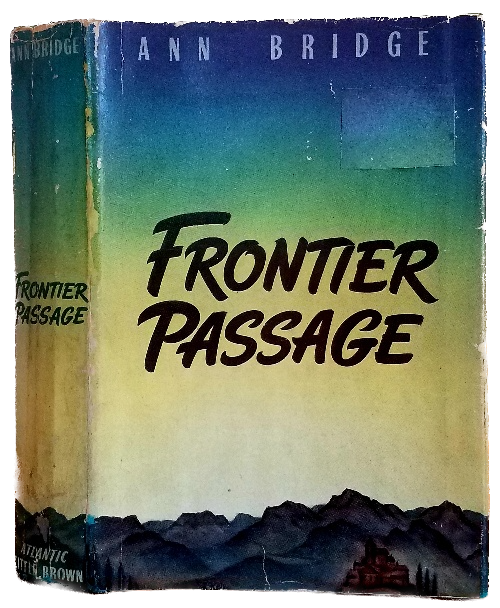
Frontier Passage, however, is set at the tail-end of the Spanish Civil War and does feature spies, sabotage, conflicted loyalties and illegal border crossings, as well as some terrific descriptions of the wreckage caused by a civil war, both human and in materiel, between Republicans (‘Reds’) and Fascists (‘Whites’). Every location in Spain or southern France is wonderfully described, and horrifyingly so when the subject is the temporary internment camps for refugees, and there is a very poignant scene when a leading ‘White’ (a female) is executed by a Republican firing squad.
Although more of a tragic romance than a thriller, Frontier Passage (and Ann Bridge) is often cited as cut from the same cloth as the novels of Helen MacInnes but whilst Bridge had a great talent for describing place, she was less interested in pace or plot. It is said, however, that Frontier Passage was used during the war as a text book by British Intelligence attempting to set up an anti-Nazi resistance movement in Spain.
VICTOR CANNING – Green Battlefield (1943)
Victor Canning (1911-1986) had already proved himself a successful author of light-hearted novels extolling everything English before WWII broke out. Called up in 1940, he trained in Wales alongside fellow author Eric Ambler and was commissioned into the Royal Artillery in 1941, He served in North Africa and Italy and at the end of hostilities was based in Florence and Venice.
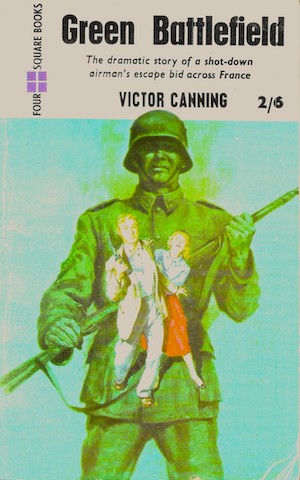
Green Battlefield was his only novel written and published during the war and when he returned to full-time writing in peacetime, he was to become an immensely popular author of thrillers (creating a credible English private eye in Rex Carver), spy stories and children’s books, many of which were filmed or adapted for television, where he was also a prolific scriptwriter. Although a conventional war story about a young shot-down RAF pilot trying to get back to England across occupied France, it marked a sea-change in Canning’s novels and after it he was clearly identified as a thriller writer. Green Battlefield is certainly thrilling as our escaping hero, with a plucky French girl in tow, heads for the coast, avoiding German troops and shady collaborators wherever possible. When there is violent conflict (and there is) it is realistically described and no punches are pulled.
Canning’s tale of heroism on the part of the decent central English character and the French civilians who aid him (in the aftermath of Dunkirk) was, perhaps surprisingly, one of the first British war stories to be translated and published in Italian as soon as the war ended in 1945. In a preface, his Italian editor wrote that she felt it an important book because it put a strong emphasis on the reaction of the youthful soul in the face of danger, qualities more readily manifested in war than in peace.
JAMES HADLEY CHASE – Get A Load Of This (1942)
René Brabazon Raymond (1906-1985), under his best known pen-name of James Hadley Chase, had already caused quite a stir in the world of popular fiction before this collection of short stories was published.
His 1939 faux-American thriller No Orchids For Miss Blandish had quickly gained notoriety for its violent and salacious content (and the title is still remembered by generations who have never read it) but was outdone by Miss Callaghan Comes To Grief in 1941, which was banned in Britain as obscene and the publisher fined. By 1942, Raymond was a Squadron Leader serving in the RAF, a day job which put something of a brake on writing fiction. He did, however, produce Get A Load Of This, a collection of short stories designed to keep his readers (mostly males) satisfied until normal service could be resumed. He described them thus: The stories have enough dynamite in them to make the average guy forget the blackout and the Blitz – which, after all, is what we want do at this moment.
If by ‘dynamite’ he meant sex, violence and very dark outcomes, then Chase was not under-selling this volume of distinctly noir crime stories set in America, Mexico and Cuba and includes a cheeky reference to meeting a character called (George) Hemingway, whilst marlin fishing off Key West. Although he never lived in the USA, Chase soaked up the world of gangsters, tough guys and bleak, brutal storytelling, threw in more sex than was probably allowed in the States, with lesbian characters as both victims and villains, and made the violence casual and inevitable. In some ways, he was pushing the envelope which Mickey Spillane, Jim Thompson and others would gleefully rip open.
James Hadley Chase went on to write some ninety novels, fifty of which were said to have been filmed, mostly in Europe where his fiction was remarkably popular, especially in France. In his native England, his work was criticised for its sex and violence and his writing was described as ‘shoddy’. In 1956 Chase and his family relocated to France and in 1969 moved to Switzerland where he became a neighbour, and great friend, of another literary exile, Graham Greene.
CHRISTIANNA BRAND – Green For Danger (1944)
Mary Christianna Lewis (1907-1988), better known under her pen-name Christianna Brand, was a highly respected crime novelist, short-story writer and children’s author who created a memorable fictional detective and, in her Nurse Matilda, the character of Nanny McPhee as she became in the film adaptations by Emma Thompson.
Brand’s 1944 novel Green For Danger is her most famous crime story and has rarely, if ever, been out of print. Set in a wartime hospital and involving a murder in an operating theatre, it becomes a notable case for Brand’s quirky detective hero Inspector Cockrill. Married to a surgeon and working during the war in a Red Cross library in a military hospital, there was no doubt Brand knew her setting, to which she added well-drawn characters and often very funny dialogue.
When filmed in 1946, the role of Cockrill seemed tailor-made for the wonderful Alistair Sim, although the role had, apparently, been first offered to Robert Morley.
CYRIL HARE – Tragedy At Law (1942)
Like Green For Danger, Cyril Hare’s Tragedy At Law, regularly appears on lists of favourite crime novels and critic Marcel Berlins called it the best whodunnit set in the legal world. It is to that seemingly arcane world the reader is introduced in the opening line of “No trumpeters!” as a peevish circuit judge arrives at a county court.
Cyril Hare was the pen-name of Alfred Gordon Clark (1900-1958), a barrister and county court judge who served on the staff of the Director of Public Prosecutions during the war. His writing career began with short pieces for Punch magazine and a debut detective story in 1937, but Tragedy At Law saw the debut of his most famous character, the barrister and amateur sleuth Francis Pettigrew.

OTHER RIPSTER REVIVALS:
#1: Peter Dickinson
#2: David Dodge
#3: Nevil Shute
#4: War Stories (Part 1)
#5: WALTER SATTERTHWAIT